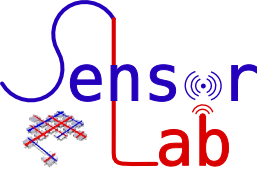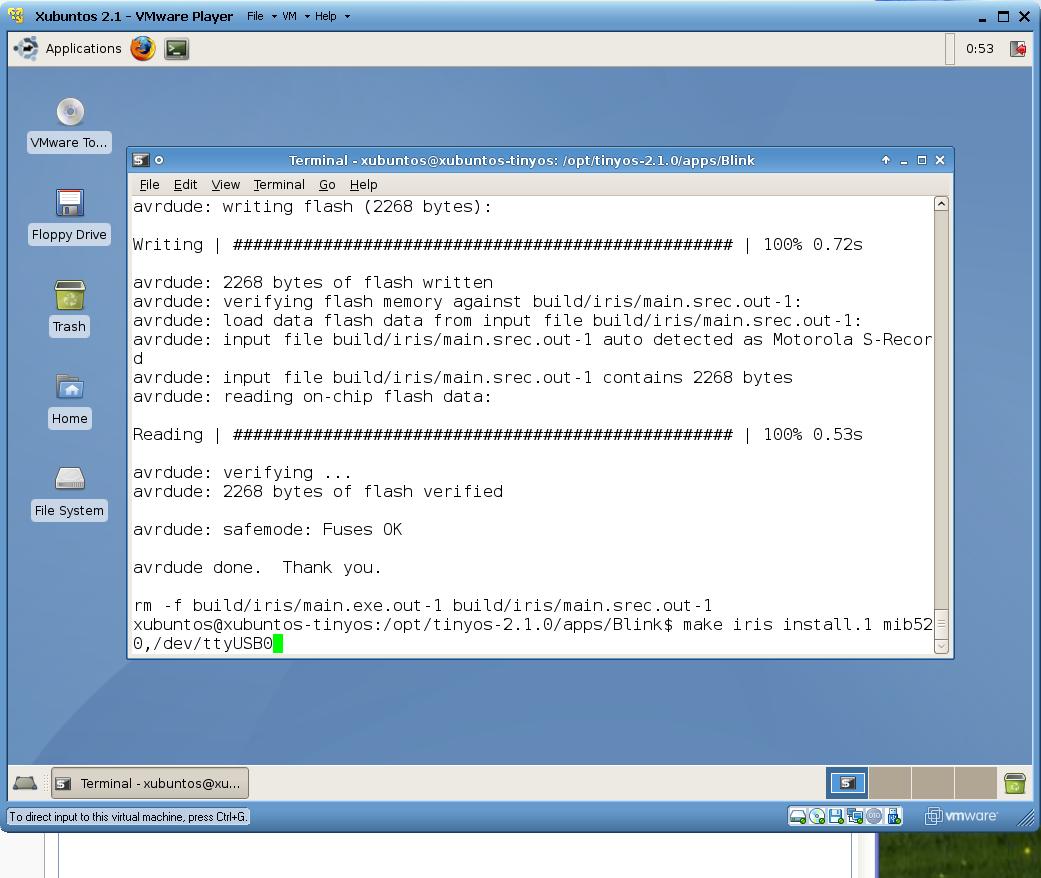SL:Introduction: Unterschied zwischen den Versionen
imported>Burghardt |
imported>Arne.bochem |
||
| Zeile 10: | Zeile 10: | ||
For more details see the [[Media:IRIS_Datasheet.pdf|data sheet]]. |
For more details see the [[Media:IRIS_Datasheet.pdf|data sheet]]. |
||
| − | + | MIB520 USB Gateway boards are available for programming sensor motes, using them with USB power, and debugging or base station uses. |
|
| + | |||
| + | === Sensor boards === |
||
| + | A number of sensor boards are available. |
||
| + | |||
| + | ==== MDA100CB ==== |
||
| + | A number of MDA100CB sensor boards are available. The include the following features: |
||
| + | * Light sensor: CdSe photo cell |
||
| + | * Temperature sensor: YSI 44006 thermistor |
||
| + | * Prototyping area: For connecting further sensors and devices |
||
| + | |||
| + | ==== MDA300CA ==== |
||
| + | The MDA300CA is a sensor board and general measurement platform. It allows for low-power wireless instrumentation and can be used and extended to be used in various areas. |
||
| + | |||
| + | ==== MTS310CB ==== |
||
| + | The MTS310CB sensor board includes the following components: |
||
| + | * Microphone |
||
| + | * Sounder: 4kHz fixed frequency piezoelectric resonator |
||
| + | * Light sensor: CdSe photo cell |
||
| + | * Temperature sensor: Panasonic ERT-J1VR103J thermistor |
||
| + | * 2-Axis Accelerometer: Analog Devices ADXL202JE |
||
| + | * Two-Axis Magnetometer: Honeywell HMC1002 |
||
| + | In addition to the sensors, it also has a sounder, which can be used as an alert, or possibly for audio communication between motes. |
||
| + | |||
| + | ==== MTS400 ==== |
||
| + | The MTS400CC board, which includes the following sensors: |
||
* Dual-axis Accelerometer: Analog Devices ADXL202JE |
* Dual-axis Accelerometer: Analog Devices ADXL202JE |
||
* Barometric Pressure Sensor: Intersema MS5534AM |
* Barometric Pressure Sensor: Intersema MS5534AM |
||
| Zeile 16: | Zeile 41: | ||
* Relative Humidity & Temperature Sensor: Sensirion SHT11 |
* Relative Humidity & Temperature Sensor: Sensirion SHT11 |
||
| + | Additionally, a few MTS420CC boards are available, which are basically the same, but include an additional ublox LEA-4A GPS module. Getting this to work with IRIS motes is still a work in progress, however. |
||
| − | A [http://user.informatik.uni-goettingen.de/~sensorlab/Hardware full list] of available hardware will be put here soon. |
||
| + | |||
| + | A full list of available hardware is also available on the [http://user.informatik.uni-goettingen.de/~sensorlab/Hardware Sensor Lab website]. More detailed [Media:MTS-MDA_Series_Users_Manual_7430-0020-05_A.pdf information] is also available. |
||
== Documents == |
== Documents == |
||
| Zeile 26: | Zeile 53: | ||
=== How To === |
=== How To === |
||
[[Media:20100107_How_to_disassemble_a_sensor_node_to_reprogramme_it.pdf|How To Disassemble a Sensor Node to Reprogram it (.pdf)]] [[Media:20100107_How_to_disassemble_a_sensor_node_to_reprogramme_it.doc|(.doc)]] |
[[Media:20100107_How_to_disassemble_a_sensor_node_to_reprogramme_it.pdf|How To Disassemble a Sensor Node to Reprogram it (.pdf)]] [[Media:20100107_How_to_disassemble_a_sensor_node_to_reprogramme_it.doc|(.doc)]] |
||
| + | |||
| + | === Printing === |
||
| + | There is a printer in the Sensor Lab, in case you require printed documentation. To use it, please start the ws1 PC, which acts as a print server for the lab. It should be reachable from ws1-6 and pc01. |
||
=== Modifications for iris motes === |
=== Modifications for iris motes === |
||
Version vom 12. November 2012, 16:11 Uhr
The Sensor Lab can be found in room 1.101 of the IfI.
Nodes Hardware
The sensor nodes we have ordered are from Crossbow technology (http://www.xbow.com/Products/productdetails.aspx?sid=264) Basically, the sensors operate in 2.4GHz ISM band. The range of the radio module is about up to 50 m indoor and up to 300 m outdoor.
For more details see the data sheet.
MIB520 USB Gateway boards are available for programming sensor motes, using them with USB power, and debugging or base station uses.
Sensor boards
A number of sensor boards are available.
MDA100CB
A number of MDA100CB sensor boards are available. The include the following features:
- Light sensor: CdSe photo cell
- Temperature sensor: YSI 44006 thermistor
- Prototyping area: For connecting further sensors and devices
MDA300CA
The MDA300CA is a sensor board and general measurement platform. It allows for low-power wireless instrumentation and can be used and extended to be used in various areas.
MTS310CB
The MTS310CB sensor board includes the following components:
- Microphone
- Sounder: 4kHz fixed frequency piezoelectric resonator
- Light sensor: CdSe photo cell
- Temperature sensor: Panasonic ERT-J1VR103J thermistor
- 2-Axis Accelerometer: Analog Devices ADXL202JE
- Two-Axis Magnetometer: Honeywell HMC1002
In addition to the sensors, it also has a sounder, which can be used as an alert, or possibly for audio communication between motes.
MTS400
The MTS400CC board, which includes the following sensors:
- Dual-axis Accelerometer: Analog Devices ADXL202JE
- Barometric Pressure Sensor: Intersema MS5534AM
- Ambient Light Sensor: TAOS TSL2550D
- Relative Humidity & Temperature Sensor: Sensirion SHT11
Additionally, a few MTS420CC boards are available, which are basically the same, but include an additional ublox LEA-4A GPS module. Getting this to work with IRIS motes is still a work in progress, however.
A full list of available hardware is also available on the Sensor Lab website. More detailed [Media:MTS-MDA_Series_Users_Manual_7430-0020-05_A.pdf information] is also available.
Documents
TinyOS
General documents can be found on http://docs.tinyos.net/index.php/Main_Page
TinyOS Iris API: http://www.tinyos.net/tinyos-2.1.0/doc/nesdoc/iris/
How To
How To Disassemble a Sensor Node to Reprogram it (.pdf) (.doc)
Printing
There is a printer in the Sensor Lab, in case you require printed documentation. To use it, please start the ws1 PC, which acts as a print server for the lab. It should be reachable from ws1-6 and pc01.
Modifications for iris motes
PacketParrot application
The PacketParrot application which is provided with TinyOS does not work on directly on the Iris motes. Thus, the following modified version can be used instead. The modifications are basically replacing the special radio component, which is used for sending and receiving, by the generic AMSenderC and AMReceiverC components.
Installation
Debian
SL:Install TinyOS 2.1 in Debian (lenny)
Ubuntu
The PCs in the sensor lab room are currently running Ubuntu 10.04.
TOSSIM
TOSSIM version in Tinyos 2.1.1 requires Python 2.5.5, which is not available in Ubuntu 10.04 (only newer versions are available). The following has been used successfully to install a compatible Python version:
sudo apt-get install build-essential gcc cd Downloads wget http://www.python.org/ftp/python/2.5.5/Python-2.5.5.tgz tar -xvzf Python-2.5.5.tgz cd Python-2.5.5 ./configure --prefix=/usr/local/python2.5 make make test sudo make install sudo ln -s /usr/local/python2.5/bin/python /usr/bin/python2.5 sudo ln -s /usr/local/python2.5/bin/python-config /usr/bin/python2.5-config
VMWare
login to the set up computer
user: wsn password: tinyos
start Xubuntos in VMWare-Player
user: xubuntos password: tinyos
Test
Note: the motelist command does not show any connected motes (I think it is because of that the hardware is very new and therefore cannot be recognised)
To find out which usb device to use, just connect the node and use the dmesg command.
Transfer test application Blink to the node attached via USB
cd /opt/tinyos-2.1.0/apps/Blink make iris install.1 mib520,/dev/ttyUSB0
Manuals (CD KIT)
CD Documents and Manuals
Media:MEP_SYS_Users_Manual_7430-0411-02_A.pdf
Media:MoteConfig_Users_Manual_7430-0112-01_A.pdf
Media:MoteView_Users_Manual_7430-0008-05_A.pdf
Media:MoteWorks_Getting_Started_Guide_7430-0102-01_D.pdf
Media:MPR-MIB_Series_Users_Manual_7430-0021-08_A.pdf
Media:MTS-MDA_Series_Users_Manual_7430-0020-05_A.pdf
Media:TinyOS-nesC_Reference_Manual.pdf
Media:WSN_Quick_Start_Guide.pdf
Media:XMesh_Users_Manual_7430-0108-01_C.pdf
Media:XServe_Users_Manual_7430-0111-01_D.pdf
See also
- SL:tmg94 -- ESXi Server for hosting Virtual Machines
- SL:PC3 -- local Windows XP
- SL:Virtual Machines
- SL:Remote Access -- reach in from the outside world
- SL:Topology -- the network address ranges, machine names...
- SL:Network_Users
- SL:Power Switches


